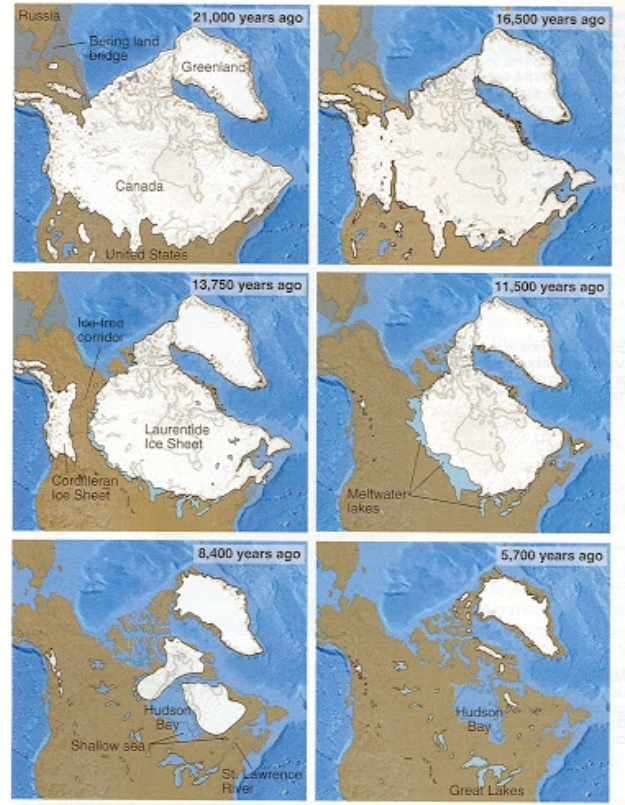Posts Tagged → flood
Climate Change’s Story, as Told by a Rock
The subject of climate change has been a political issue for about ten years. Before that it was called global warming. Before that it was called global cooling. Despite having dramatically different, even diametrically opposed, oppositional names, this subject of earth’s changing climate has been treated the same by political activists for about 30 years. No matter how different, under all rubrics it has been presented as a result of planet-altering human intervention into Planet Earth’s fundamental forces.
In all of the undocumented claims presented about this subject over the past thirty years, especially the fake junk science claims, the ignored elephant in the room has always been the very well and long-documented evidence of great periods of climate change pre-dating the appearance of humans on Planet Earth. In other words, climate change/ global warming/ global cooling did not automatically appear in 1985 because Al Gore wrote a book about humans emitting too much carbon dioxide. Nope. The scientific elephant in the climate change room was standing here all along, because decades of non-politicized scientific inquiry demonstrated how mile-thick ice glaciers covered northern America, Canada, and northern Europe and Asia many times over the past 100,000 years.
That is, a natural ongoing cycle of climate change, real dramatic alterations to the face of the planet, even without one human being present to contribute one breath of carbon dioxide to it.
Well, here is the short and easy story of actual, real climate change; the long documented climate change that shaped the land you are standing and driving on every day. This big story is told by a simple humble rock. Here is a picture of that rock (below), unearthed the other day. It was unearthed about 600 feet above the Pine Creek stream bed and channel. Until it was unearthed, it was entombed on a hillside way above the existing channel, in mostly clay dirt amid sharp shards of shattered sandstone, all jumbled together like a giant mixer had tossed them around.
Look carefully at this stone.
It is rounded, unlike most of the other rocks around it in the dirt from whence it recently emerged. Someone with a bit of curiosity would ask “Gees, this rock looks totally different from the rocks around it. It is rounded like a typical long water-washed and tumbled river cobble I can find in any stream bed in the world. Now why is this rounded rock sitting hundreds of feet above the Pine Creek river bed? How did it get all the way up here?”
Great question! In most American class rooms, asking this question might get you ejected, or a bad grade from a fake educator who doesn’t want you asking good questions, but instead you are supposed to repeat a mantra of junk science that ignores the actual science represented by this simple little rounded rock.
Pine Creek’s history is retold at Leonard Harrison State Park, in DCNR geology circulars available online, and in many other places and publications. It won’t be reiterated at length here. But we do provide a history lesson in a nutshell.
Essentially it goes like this: Until about 15,000 years ago, Pine Creek flowed northward into the Genesee River watershed. After the last glacial age ended 20,000 years ago, the Laurentide Glacier began to melt, as prior glaciers there before it had melted. As the glacier melted, a pool of water built up against an ice dam, which eventually broke from the weight of the water and the thinning ice. When the ice dam broke, an enormous torrent of water was unleashed southward as a tidal wave. As it raced southward, the tidal wave followed the landscape’s natural contours, including the river bed of north-flowing Pine Creek.
As soon as the tidal wave hit the Pine Creek stream bed, the tidal wave followed that natural channel southward, scooping up hundreds of millions of tons of stream bottom rocks, as well as surrounding ledgerock. We have seen the videos of the Japanese tsunami from several years ago, and this one probably looked similar. Thus, an increasingly muddy tumultuous mess of water, dirt, and rocks flowed southward to the West Branch of the Susquehanna River. Along the way rocks like our little rounded river cobblestone here were picked up and deposited high up on the river channel’s slopes.
Even though the rock had come from deep down in the river bed, it remained in place on the hillside as the roaring water receded to the stream flow we know and love today. The rock is an artifact of climate change, real honest-to-goodness climate change, devoid of any human causation or intervention.
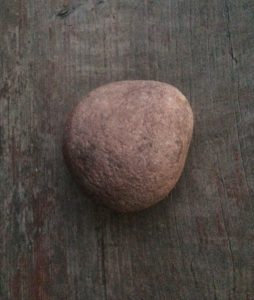
Our pet Pine Creek stream bed rock now in Lycoming County, PA, probably originating due north in Steuben County, New York, 15,000 years ago, already rounded from thousands of years of tumbling in a stream bed
Ever since that melting glacier released that tidal wave and placed our little rock here on the hillside, Pine Creek has flowed south, into the West Branch of the Susquehanna River, and not northward into the Genesee River. And as a result of that huge rushing torrent southward, the Pennsylvania Grand Canyon was cut and shaped.
Climate change, folks. It is as natural as the Sun rising and setting on the Earth’s horizon. It can be real. It was real, and still is real and ongoing, even without human involvement. But you probably won’t find the real climate change science taught any more, because it is contrary to a radical political narrative that tells us modern capitalist societies are evil and destructive and must cease and desist, because we alone are destroying the Earth’s climate.
Which just goes to prove that Marxism really is anti-science, anti-truth, anti-fact, and anti-human. Shame on the Marxism Climate Change fraudsters who represent themselves as guardians of the environment. They are no such thing. They are destroyers of the environment, as every Marxist society’s destroyed environment demonstrates.
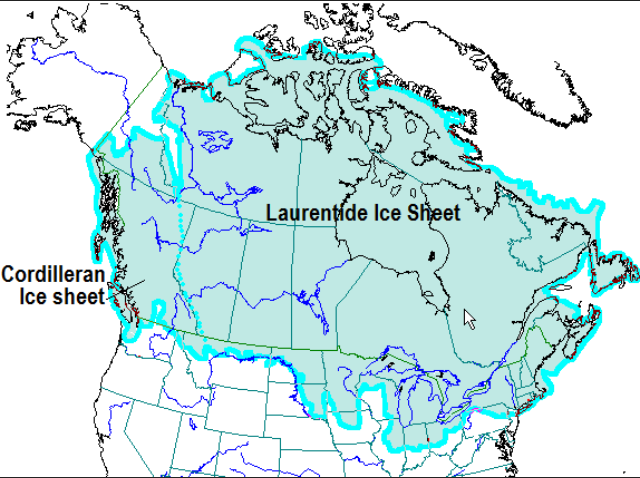
Shhhh! Don’t tell anyone you saw this, because the “climate change” activists will have me locked up for disseminating actual science!
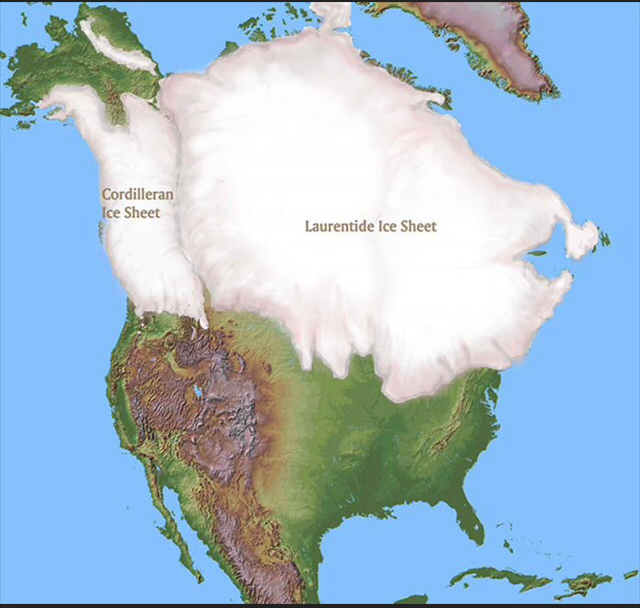
All this climate change happened before humans were even present on the planet, let alone before we and our cows began farting so much and creating green house gases…
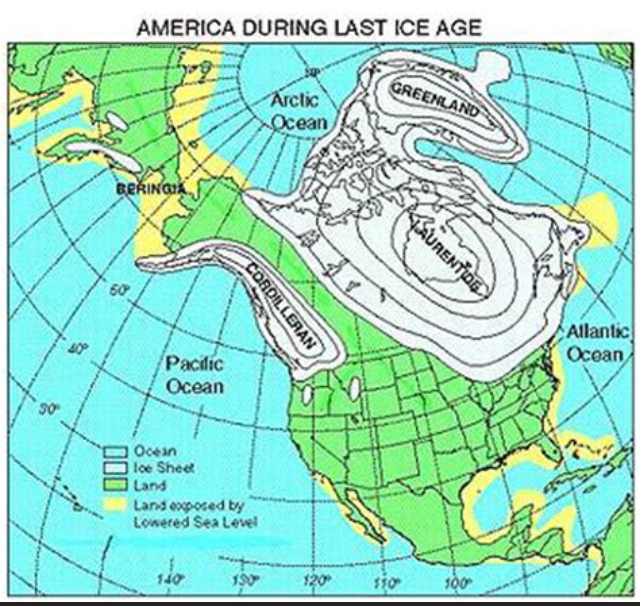
Be careful showing this glacial map to a New Yorker. They believe that New York City pre-dates all human civilizations and was founded by the gods, who would never let a mile of ice stand on top of their sacred ground.
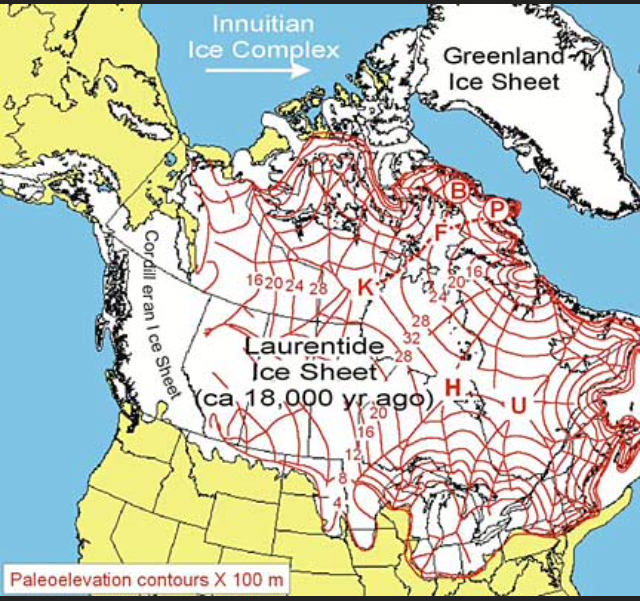
Showing this image in a modern class on “climate change” is like showing a crucifix to a vampire, and you will probably be ejected from the classroom and declared unfit for indoctrination by the fake teacher. Be careful how you use this science.
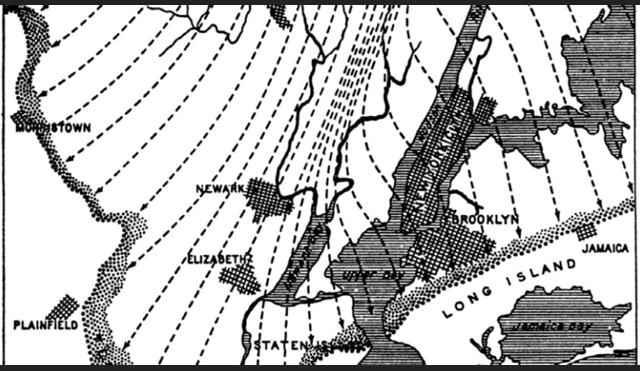
Oh no, we did it, we showed New York City under ice. NYC mayor Bill DeBlasio will probably ban me from entering NYC henceforth.
A rock from the basement of time
Norman McClean wrote his book “A River Runs Through It,” about his childhood in southwest Montana. Growing up hunting and fishing brought him into close contact with unusual examples of natural history in the field, including really neat geological samples.
Those rocks that he found were what his Presbyterian minister father called “rocks from the basement of time.” Meaning that they were very old, from the beginning of the world. McClean effectively connects his reader with the sense that while standing in a trout river in Montana, holding one of these ancient rocks, he was transported, and the reader along with him, into a kind of time machine and also a giant web of life and history.
This phrase “rocks from the basement of time” always stuck with me, as it is so illustrative of how such basic, simple, everyday things in our lives can yet be so important or significant. And inspiring.
Here below is one such rock from the basement of time, but from this northcentral Pennsylvania corner of the world’s basement. 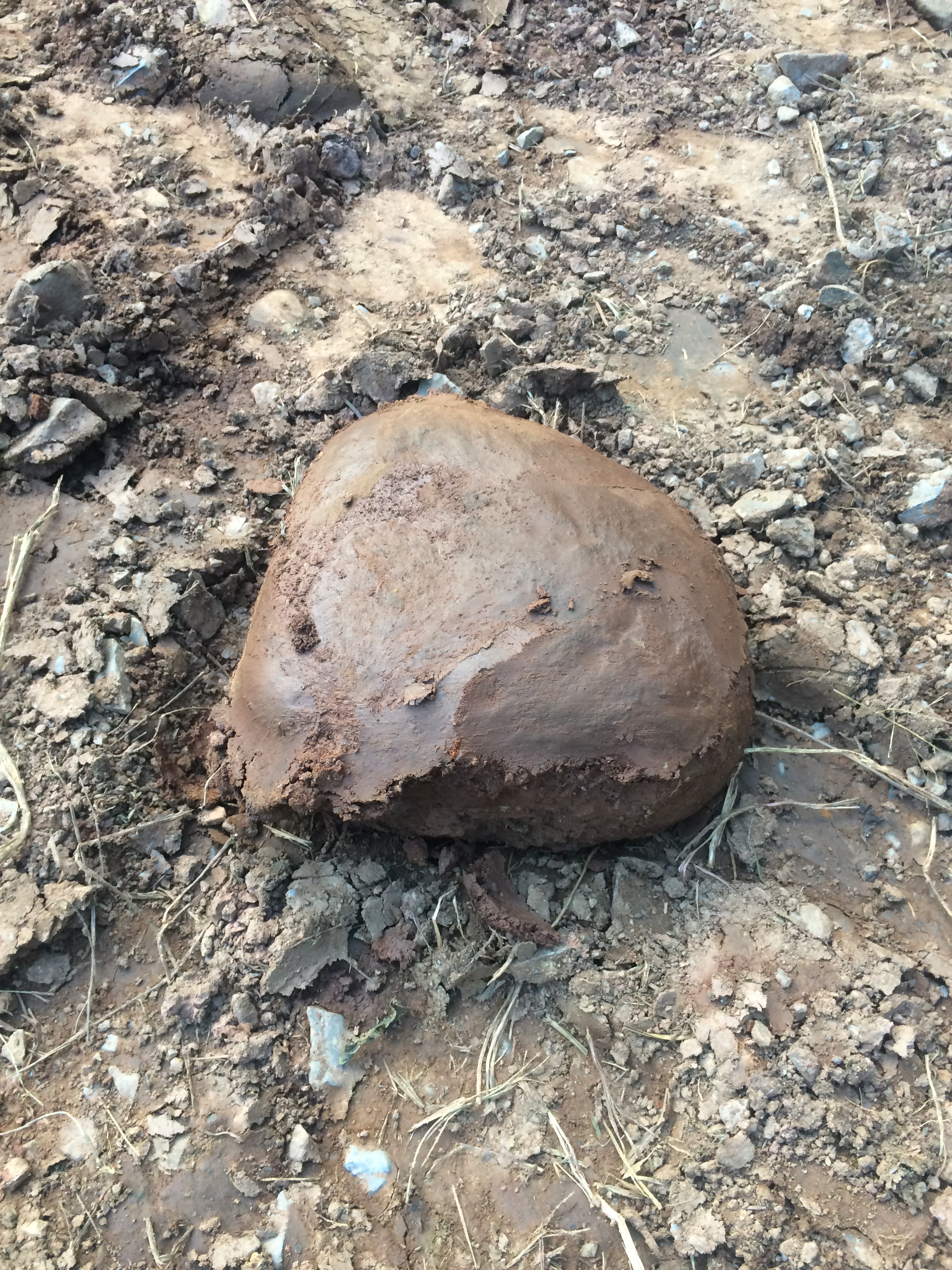
This large, rounded river cobble was unearthed today in the dirt bank behind the cabin in Pine Creek Valley, about four hundred feet above the Pine Creek riverbed. This rounded river stone started out as a squared chunk of slate hundreds of millions of years ago, and was then gently rounded and sculpted by flowing water, and sediment and rocks being pushed downstream over who knows how long. Its most recent path in its long life had it deposited in the great flood that created Pine Creek as we know it today, 10,000 years ago, after the most recent ice age.
At the end of that last ice age, a huge ice dam in the Finger Lakes region melted and burst, pouring an entire inland sea down through the little creek bed that was then north-flowing Pine Creek. All that water flooding the river channel caused Pine Creek to reverse its flow, and in that process enormous amounts of both shattered rock and rounded riverbottom cobble churned its way south, settling out along the walls of the canyon, eventually far far above, almost impossibly above, the new river channel and bed.
When I think about that raging torrent of mud and rock from a hundred miles upstream, filling up the valley’s river hundreds of feet higher than its usual height, and depositing ancient large river stones far above their natural resting place, I think “Wow.”
And here at my feet is all of that incredible story, told in one pretty much otherwise unremarkable rock from the dirt bank behind the cabin. Which I now look at and think of as being part of the basement of time. And suddenly I feel totally differently about my life and everything in it.
A mighty wind
Astute followers of weather may have noticed the past few years have been marked by strong winds, each and every year. Usually around seasonal changes. Really strong winds. Howling.
Silly people will jump to the conclusion that this is yet more evidence of “global warming,” or “climate change,” because God knows, everything that happens is “evidence” for these theories, no matter what.
But the truth is actually much more interesting and compelling. The cause of these winds is Planet Earth’s changing polarity.
Our planet’s magnetic polarity switches every 100,000 years, or so, give or take.
This means that what is now the North Pole becomes the South Pole, and vice versa.
The magnetic field surrounding our planet is responsible for our existence here, because it provides a shield against cosmic rays and radiation, including from our own sun. Mars was once a watery oasis, a lot like Earth, but when its magnetic shield weakened, solar radiation stripped the planet’s surface of water and everything else needed for life. Including its atmosphere.
Because Earth’s magnetic shield is so strong, we survive. However, our magnetic shield is weakest when the polarity shifts. It’s like trying to walk when you’ve bent over with your pants around your ankles…you can kind of shuffle forward, but you won’t be winning any running or walking competitions.
As a result of our weakened magnetic shield, it is kind of like Star Wars ship-to-ship fighting scenes, where some of the laser bolts get through and kind of rock the ship. It is alarming, but not really damaging.
Oh, people can be damaged by the unusually strong sun’s rays, if they are out without clothes. But we already know that is foolish behavior.
But more than anything is the effect on our climate, and the resulting winds. Though it is not totally understood, the increased heat and solar radiation on our planet’s surface definitely causes temperatures to rise, and it can cause what feels like rough weather, though it is probably relatively calm compared to other planets.
There is nothing we can do about this polarity shift, and the resulting mighty winds, other than batten down the hatches and try to adapt.
More than anything, watching this happen reminds us of how tenuous life on Planet Earth is, and what a narrow window it was that opened to permit us to move forward technologically and materially. We have perhaps foolishly built high rise buildings and overhead power lines during a relatively narrow window of relative calm, but it is what it is. We cannot go back over all our infrastructure and rebuild it, though we are seeing the benefits of buying up private property along floodways to prevent further material destruction.
With these strong winds, we are just going to have to get used to them, and hope the polarity shift doesn’t poop out halfway through. Because then we’d all become Martians.
Warmer weather can’t come too soon
What began as a happy trip to the wood shed for a load of seasoned oak in the Fall is now a crabby trudge through deep snow and ice, a drudgery opposite the cheerfulness felt with the first flames to beat back Winter’s early chill.
Spring warmth cannot come too soon. Naturally, it will arrive, melt the Arctic snow cap occupying my lawn, and probably result in some Biblical flood carrying my home down river to the Chesapeake Bay.
Speaking of floods, and flood insurance, I am hopeful that the insane congresswoman Maxcine Waters will have her bizarre legislation permanently overturned, so that people can either afford to own their homes (something she is not familiar with or supportive of) or the Federal government will buy out the landowners so the societal costs and benefits are not concentrated on just the private property owners. Government cannot change the social contract in one week. Well, under liberals it can, of course. Let’s rephrase that: Government should not restructure the social contract in such a short time that private property owners see their investments destroyed overnight. That would be good government, something unknown to Maxcine Waters and her fellow liberals.
Breezy Point, NY, Hit Hard by Sandy
Some places are just off the radar, and sometimes the closer they are to large metropolitan areas, the easier they hide in plain view.
Breezy Point is such a place. A slice of Heaven in an otherwise old, somewhat decrepit New York metro area, Breezy Point is a small seaside village nestled in the dunes between Jamaica Bay and the Atlantic Ocean.
About 99% Irish Catholic, it’s utterly safe, pleasant, and home to several welcoming real Irish pubs. For years, Breezy has been my main fishing destination. Its proximity to public land, private beaches, normal people, excellent fishing, and many friends makes it a natural venue to introduce my kids to surf fishing, beach bonfires, and rare friendly exchanges with urban strangers.
Sadly, Breezy took a big hit from Hurricane Sandy. Between unprecedented flooding and a huge fire that has eaten at least fifty homes now [UPDATE: 100 HOMES, developing], the place is really hurting. If nothing else, Breezy’s residents are hearty, able, and unwilling to move into “The City.” So it’ll be rebuilt. This coming Easter I may finally be able to organize the first seaside service with bagpipes that also kicks off the start of the striped bass run. I’ve raised the subject and been met with warm welcome by some locals. Given the state of things there now, it might be a good start.
To my many Breezy friends:
May the road rise to meet you.
May the wind be always at your back.
May the sun shine warm upon your face.
And rains fall soft upon your fields.
And until we meet again,
May God hold you in the hollow of His hand.
Interesting Detritus from the Flood of 2011
September’s historic flood waters brought interesting gifts from upstream, nonchalantly and gently leaving them stranded on my lawn and driveway.
How did the three-gallon gas can end up in the flower bed, upright, as though I had left it there myself while mowing the lawn?
Whose pack of 1992 Topps baseball cards had been burnt around the corners before mysteriously arriving? And why were they burnt? A frustrated mother or angry girlfriend?
The cigarette pack was the most incongruous of all, at least in our neighborhood. Lying there in its minty mentholy promise, it looked like a social land mine, or lawn cancer. My tired hands found it first of all the new things, and trashed it first. Mind you, I’m an occasional pipe smoker and hardly a tobacco Prohibitionist. But let’s face it, cigarettes are a dirty habit. The soggy pack reminded of that.
Various childrens’ things, like a slipper, a sneaker, some small plastic toys, all were straight forward examples of the shared family sameness from Scranton to Harrisburg. Those were easy to trash. Heck, I’m throwing away my own kids’ leftover artifacts every week, anyhow, so the newcomers were nothing new and in good company.
Someone is missing an important part of their split rail fence. Not to waste, it’s now part of my eight-cord wood pile and will heat my home for an hour on some upcoming winter day. Undoubtedly the least showy or remarkable, it is probably the most useful of all the flotsam. at least after I chainsawed it into 18-inch lengths.
Some buildings in my neighborhood had finning, flopping, fish in their basements. Now you know that if the fence rail felt out if place lying in my lawn, then those fish certainly felt like a fish out of water, so to say. They probably survived and are back in their river now, albeit a bit more migratory than their kind is accustomed to. Just this year, fellas, ok?
While the five feet of water in the basement upended our plans and schedules for the next six weeks, at least, we enjoyed the unusual fruits dropped off by Mother Nature on her way down to the Chesapeake Bay that September weekend.
Flood of 2011 Experiences In a Nutshell
Ladies and gentlemen, like many families along the Susquehanna Valley, our clan experienced a lot of displacement, loss, and discomfort as a result of the five feet of water in our basement.
But challenges like the flood are just a test, a test of our abilities, our faith, our ability to be a good neighbor, and our friendships.
It also tests whether or not businesses are willing to be good neighbors, or if they try to take advantage of people who are vulnerable and needy.
Here are some kudos that came out of our experience, turning the lemons into lemonade:
***Big thank you-s to Ed, Dominic, and Devon, friends who over-rode my last-minute living-in-denial mentality and simply showed up, despite my protests, and helped our family carry hundreds of pounds of things out of the basement and up to the first floor, and then from the first floor to the second, as the flood warnings changed hourly. Just in time. Without their muscle and hard work, our personal and financial losses would have been much higher.
***Big thank you to long-time friend Mark Brodsky, who selflessly dropped off a huge generator on my front porch on Friday morning, which kept the sump pumps going long after the electricity had been turned off in our city.
***Big thank you to Mark Woodland, an amazing friend and neighbor, who helped me set up sump pump after sump pump in our basement, despite the late hours, the gross water, and the hard work. Mark is a gifted technician of anything involving mechanics. Without Mark, I likely would have ended up with the pump hoses circling back into the house.
***Thanks to Rabbi Ron Muroff who descended like an angel to help out himself and then with other volunteers (thanks, Judge Solomon et. al.) when we needed help most. We are not members of his house of worship, but we will be making a donation to it.
***Thanks to neighbors Steve and Dick for helping with the sump pumps and generator when I was running helter-skelter.
***Thanks to the Harrisburg City Police for putting in long hours chasing down would-be looters in our neighborhood, putting up with ridiculous answers from these guys, and for bringing comfort to me when our neighborhood was dark, abandoned, and completely vulnerable to break-ins and looting. Officer Bobby Yost, call any time for a BBQ in our back yard. You earned it, buddy.
***Thanks to the two very likeable Allstate adjustors, Tim and Paul, for treating us fairly and kindly. These two suuthin good ol’ boys from Louisiana are hunters, fishermen, even-keeled, and really all-American in all respects. We enjoyed their company as well as their hard work to ensure that we were treated fairly. Hey, fellow Central Pennsylvanians, these guys from the bayous are our kind of people. If you desire a vacation in a very different part of the nation but still want to feel at home, I think we can safely recommend coastal Louisiana.
***Thanks to FEMA for helping so many of our communities. We pay our taxes for this kind of service, and it’s nice to see our government provide service with alacrity and a smile. James Ferguson, our guest FEMA employee (well, a contractor) all the way from Tacoma, had an easy, caring way, and a hard work ethic.
***Thanks big time to our US Mail carrier, John, who stopped briefly to talk with me on Friday, September 9th, to strategize about the best paths for him to take to various neighborhood homes under feet of muddy water. Yeah, we know that the US Mail folks are under the gun in so many ways, but John delivered our mail despite encountering conditions that he could have easily walked away from.
***Thanks to Todd at Rainbow Cleaning. Although he made money, Todd also helped us above and beyond the call of duty. Without his dozen airplane-prop – sized fans and two industrial dehumidifiers for almost two weeks, our basement would have never really dried out. Todd provided good advice, too.
***Thanks to my parents and to the Family Boss, Viv, for keeping us all on the straight and narrow despite the strong urges I often felt to run screaming in circles.
Josh
